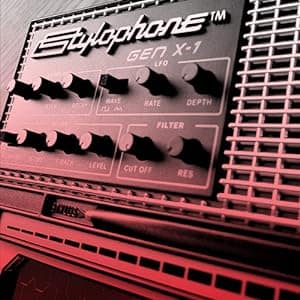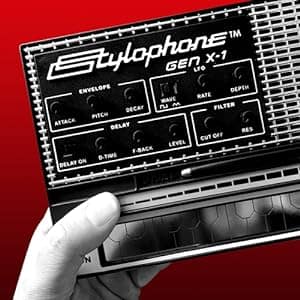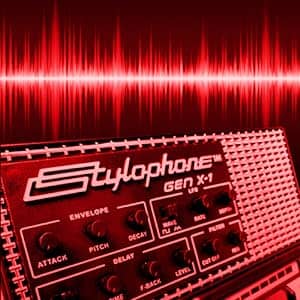- PLAYABILITY: Two ways to make sounds with the stylus. The keyboard to make distinct notes and PRESS FIRMLY the sound strip above the keyboard to slide between notes on a scale.
- PORTABILITY: Take this synth anywhere. Battery operated with built in speaker. Audio line out for headphones and/or external speaker. Audio in to use as an effects unit.
- ENRICH THAT SOUND: New features include, LFO (with square and triangle waves), Low pass filter (cutoff/resonance), Envelope (attack/decay).
- ANALOG DELAY FEATURE: Add space to your sound with delay time, feedback and level.
- ADDED FEATURES: Sub octaves -1 & -2 switch, this enriches your sound by adding a second frequency below your source sound. AND a Pulse Width Modulation button which can be used to create a chorus effect.
Product Description
Introducing the Stylophone Gen X-1, our new portable analogue synthesizer. From quirky beats to haunting melodies, you can twist and warp every note in the palm of your hand. Packed with features, you’ll be amazed at what the Gen X-1 can do. Beginner or music pro, if you like the synth sound you’ll love this. From the makers of the iconic Stylophone, it’s the next generation.
In July 1969, David Bowie created ‘Space Oddity’ using the Stylophone, realising the potential of its unusual voice. Its space-age, buzzy sound suited the song perfectly.
The new Stylophone Gen X-1 is all I love about Stylophones and more. Depending on how I set the controls and play it, the Gen X-1 can sound rich and interesting or klunky and grating. I plan to incorporate it into my little home recording studio, but I also enjoy it as an entertaining, portable diversion for musical noodling.
Unlike the original Stylophone, which is a basic a transistor organ, the Gen X-1 is a basic monophonic, analog synthesizer. The iconic Stylophone keyboard and stylus control an oscillator that is shaped by a low pass filter and envelope generator. A low frequency oscillator, two sub-oscillators, a pulse width modulator and an analog delay circuit further color the sound. The resulting audio output — best heard through headphones or an external amplifier because the built-in speaker isn't very loud — can range from bizarre sci-fi trills, sirens and blips to rich lead and bass synth tones that remind me of some of the timbres of "real" synths from the likes of Moog, Korg, or Oberheim.
The Gen X-1 is charmingly imperfect. Playing with a stylus on its metal keys is a bit of a challenge. (By the way, right out of the box, the keyboard and stylus will crackle and sputter a bit. This seems to be a normal thing with all Stylophones that are either new or have gone unplayed for a long time. Simply rubbing the keys and the tip of the stylus with your fingers or a cleaning cloth will help remove some invisible residue that builds up and interferes with the electrical contact. Playing with firm stylus pressure helps, too.) One of the quirks of the Gen X-1 is that if the stylus comes to rest in a narrow groove between keys, the resulting sound is going to be about an octave higher. If you watch what you are doing and bring the stylus to a stop in the center of a key, this effect can be avoided. It doesn't seem to be an issue when playing a glissando, quickly passing over the grooves from one key to the next. I am sure many players will find a way to use this pitch jump in intentional and interesting ways.
The Gen X-1 supplements the traditional stylus-activated keyboard with a ribbon controller. The ribbon responds to pressure from a fingertip or either end of the stylus. The ribbon isn't limited to the traditional frequency intervals of a keyboard. Its effect is more like a fretless string, a theremin, or a trombone. I find the ribbon most playable by holding the instrument facing away from me, with my finger on the ribbon as if it were a string on a cello or an upright bass. Anyone who has played an Otamatone or a Korg Monotron will get the hang of it right away. Incidentally, the Gen X-1 ribbon is much longer than the one on the Monotron. I think that makes it easier to play.
The analog delay, in small amounts, can serve as a pseudo envelope release. (The envelope generator has attack and decay settings, but not sustain or release.) With moderate settings, it adds a fun, scifi or '60s surf guitar quality to the synth tone. At more extreme settings, the analog delay produce a feedback loop that would be right at home in a noise musician's arsenal. It could also be quite useful for generating noise effects to be recorded and used in a digital sampler.
The low pass filter has a resonance control that will self-oscillate at extreme settings. An aux input allows the filter to affect another instrument or sound source.
The tuning knob on the underside of the instrument can be used to change the effective range of pitches that can be played on the two-octave keyboard. The total pitch range is about the same as a piano. The tuning knob can also be used to transpose keys up or down a few steps, or fine tune the keyboard to match other instruments in a band. (It is not limited to A=440.)
A hidden control can be used to fine-tune the instrument if the oscillator drifts too far out of tune between keyboard intervals as the instrument ages. This is an advanced feature that you shouldn't have to mess with under typical circumstances for quite a long time, if ever. This setting is factory-tuned and should be okay right out of the box. It is good to have, though, and is one of the things that makes the Gen X-1 more than a mere toy.
If you already know how to use an analog synthesizer, the Gen X-1 will be immediately familiar. If you are new to synthesizers, it will be a fun learning tool. Turn some knobs and see what happens! Read the owner's manual and find out why. The Gen X-1 will make an ideal gift to introduce a child (or an adult) to electronic music making. For an experienced electronic musician, the Gen X-1 makes an engaging, portable tool for composing, passing the time, or maybe even for recording or stage performance.
The Gen X-1 certainly will invite comparisons to the Korg Monotron series. I have owned all three Monotrons. I can honestly say that I find the Gen X-1 much more fun and useful and I consider it a better value. If you must choose, go with the Gen X-1.
The Stylophone Gen X-1 provides a lot of features and capabilities for such a reasonable price. As a creative toy for sparking a child's talent and imagination, or as an analog synthesizer for a grown-up musician, it is definitely worthy of your consideration.
What I find undesirable is that the tuning, although stable once adjusted, seems intent on providing either too many or too few notes for the interval. I can get the keys to provide almost a perfect octave, perfect fifth or fourth by utilizing the tuning dial on the back or manually adjust the pitch. I can easily get them to provide a full 12 notes per octave, plus the extra octave note, for 13 distinct notes total, or 11 notes per octave, the 11th note being a perfect octave, for 11 distinct notes, but not at the correct intonation in between where it should be for traditional Western music.











